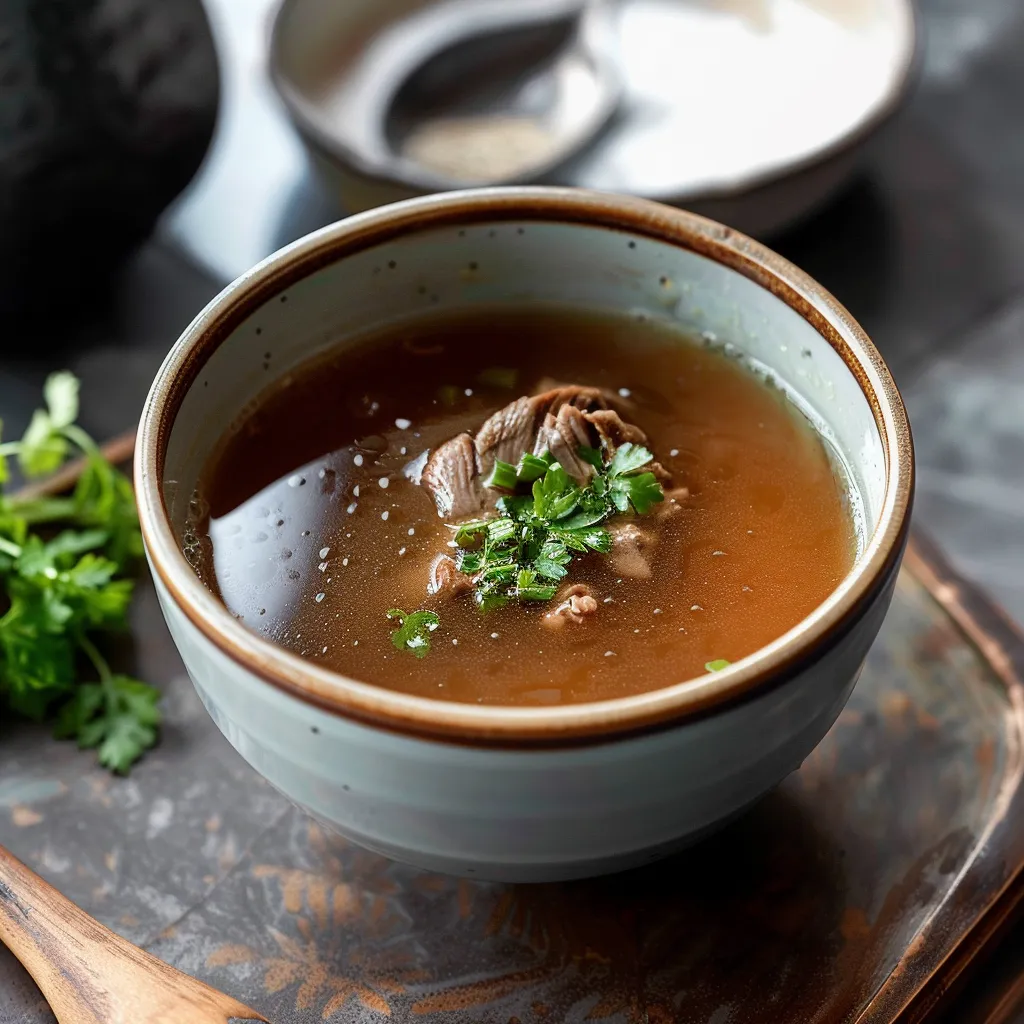 Pin it
Pin it
This rich homemade beef stock transforms ordinary dishes into extraordinary meals with its deep, complex flavor that simply can't be matched by store-bought versions. The slow-simmered goodness becomes the foundation for countless recipes in my kitchen.
I first started making homemade beef stock after receiving my grandmother's recipe book, and it has become something of a monthly ritual in our house. My family knows that stock day means incredibly flavorful meals are coming soon.
Ingredients
- Marrow bones: Provide gelatin and richness that gives body to the stock
- Meaty bones: Contribute deep flavor while the cartilage adds texture
- Beef stew meat: Ensures a robust meaty taste that forms the foundation
- Onions, carrots, and celery: Create the aromatic vegetable base
- Fresh herbs: Add layers of complexity without overpowering
- Tomato paste: Adds umami and a subtle acidic note
- Dried mushrooms: Amplify the earthy quality without muddying the flavor
- Parmesan rind: Optional but adds incredible savory notes
- Anchovy fillets: Boost umami without adding fishiness
- Apple cider vinegar: Helps extract minerals from the bones
- Salt: Enhances all the flavors but is used sparingly
Step-by-Step Instructions
- Layer ingredients strategically:
- Place smaller ingredients like herbs and spices at the bottom of your pot with larger bones and meat on top. This strategic layering makes the skimming process much easier later and ensures even flavor distribution throughout the cooking process.
- Bring to a gentle simmer:
- Slowly heat the pot until it barely reaches a boil then immediately reduce to the lowest possible heat. Maintaining this gentle simmer is crucial as vigorous boiling will create a cloudy stock with an unpleasant texture. Look for occasional tiny bubbles rather than rolling movement.
- Skim as needed:
- Use a small fine mesh sieve to remove any foam that rises to the surface during the first 30 minutes of cooking. This step is primarily cosmetic as it creates a clearer final product but the flavor remains excellent either way. Be patient and remove only the foam not the flavorful liquid.
- Practice patience:
- Allow the stock to simmer for a full 6 hours minimum with 8 hours being ideal. The magic happens in those final hours as collagen breaks down and flavors meld. I often start mine mid-morning on a weekend so it can simmer all day while I attend to other things.
- Strain thoroughly:
- First remove large pieces with tongs then pour through a fine mesh strainer. Resist the urge to press on the solids as this can force cloudy particles into your clear stock. The meat can be saved for other uses but discard the spent vegetables.
- Cool properly:
- Place your strained stock in an ice bath in your sink to rapidly bring down the temperature. This quick cooling prevents bacterial growth and preserves flavor quality. Never put hot stock directly in the refrigerator as it can raise the temperature of surrounding foods.
 Pin it
Pin it
The dried mushrooms are perhaps my favorite secret ingredient in this recipe. My grandmother never used them but I discovered their transformative power during a cooking class years ago. Just three small pieces add an incredible depth that makes everyone ask what my secret is.
Storage Wisdom
After straining and cooling your beef stock properly store it in the refrigerator for up to 5 days. The hardened fat cap on top actually helps preserve it by creating an airtight seal. For longer storage freeze in portion sizes that match your cooking needs. I find 1-cup and 2-cup portions most versatile along with some ice cube-sized amounts for small flavor boosts.
Before freezing be sure to stir the chilled stock thoroughly as flavor compounds tend to settle during refrigeration. This ensures each frozen portion has consistent taste and texture. Label containers with both the date and exact contents as it's surprisingly easy to confuse different stocks once frozen.
Creative Uses Beyond Soup
While beef stock naturally excels in traditional soups and stews its applications extend much further. Use it to cook grains like rice or barley absorbing the rich flavor. Reduce it by half for a sauce base or by three-quarters for an intensely flavored glaze for meat dishes.
I often use a splash when sautéing vegetables or deglaze a pan after searing meat. Even just a tablespoon added to mashed potatoes elevates them substantially. The concentrated flavor works wonders in risotto or as the cooking liquid for braised vegetables.
Cultural Significance
Bone-based stocks represent one of the oldest cooking techniques in human history with evidence dating back thousands of years. Nearly every culinary tradition worldwide has some version of slow-simmered bones and aromatics forming the foundation of their cuisine.
The French call it "fond" meaning foundation while Italian cuisine refers to it as "fondo." In Asian traditions beef bone broths are often consumed directly as nourishing tonics. This process represents true culinary wisdom maximizing both flavor and nutrition from ingredients that might otherwise be discarded.
 Pin it
Pin it
Frequently Asked Questions
- → What kind of bones work best for beef stock?
Marrow bones and meaty bones are ideal, as they provide both flavor and gelatin for a rich texture.
- → Can I skip skimming the stock?
Skimming is optional but recommended for a clearer stock. It does not affect the flavor significantly.
- → How long should I simmer beef stock?
Simmer for a minimum of 3-4 hours, but 6 hours or more will produce a deeper flavor.
- → Should I roast the bones and vegetables first?
Roasting is optional. It adds a caramelized flavor but requires more effort compared to simmering the ingredients directly.
- → How do I store beef stock?
Cool the stock by chilling it, remove excess fat, then portion and freeze in bags or containers for convenience.
